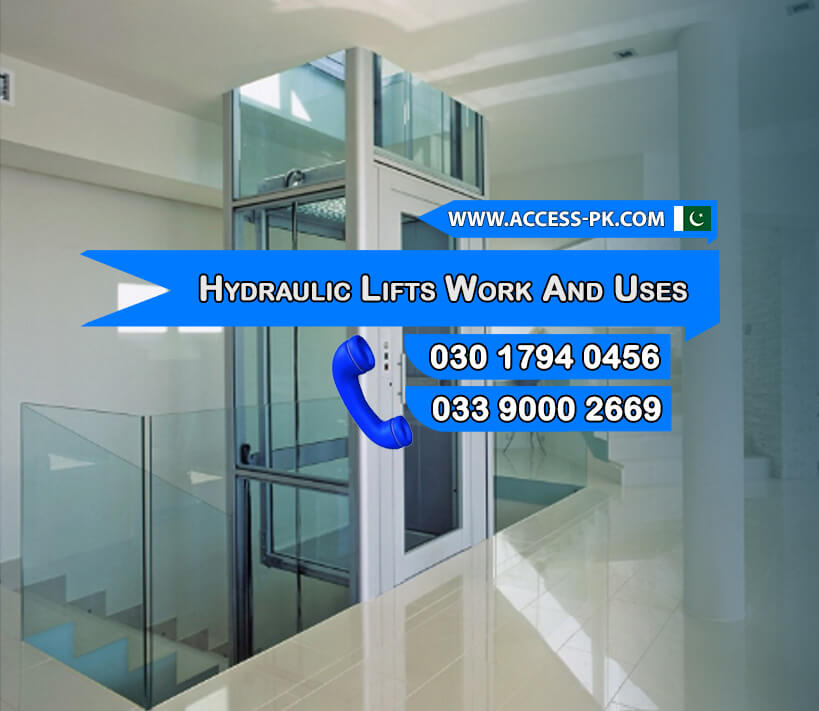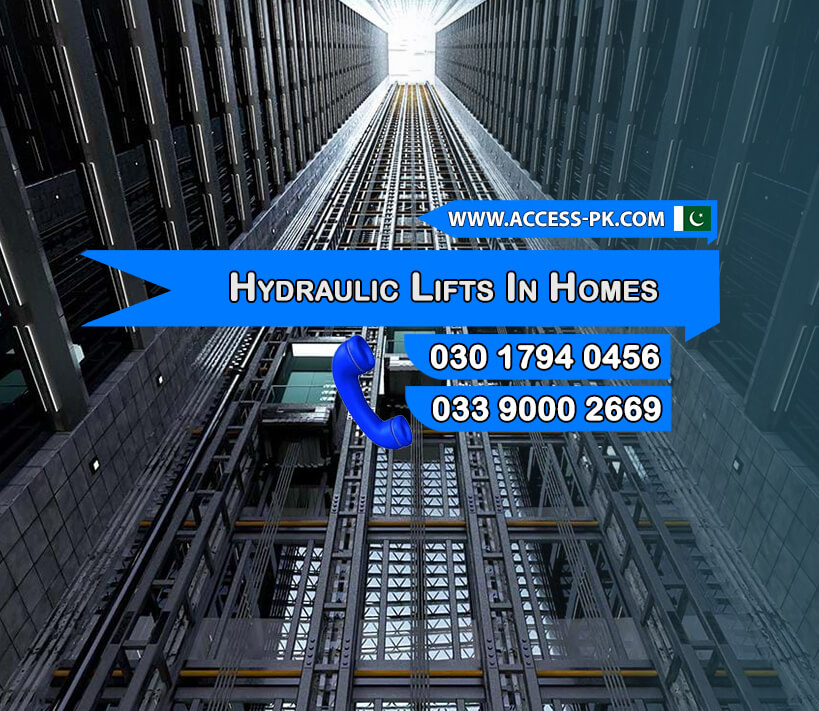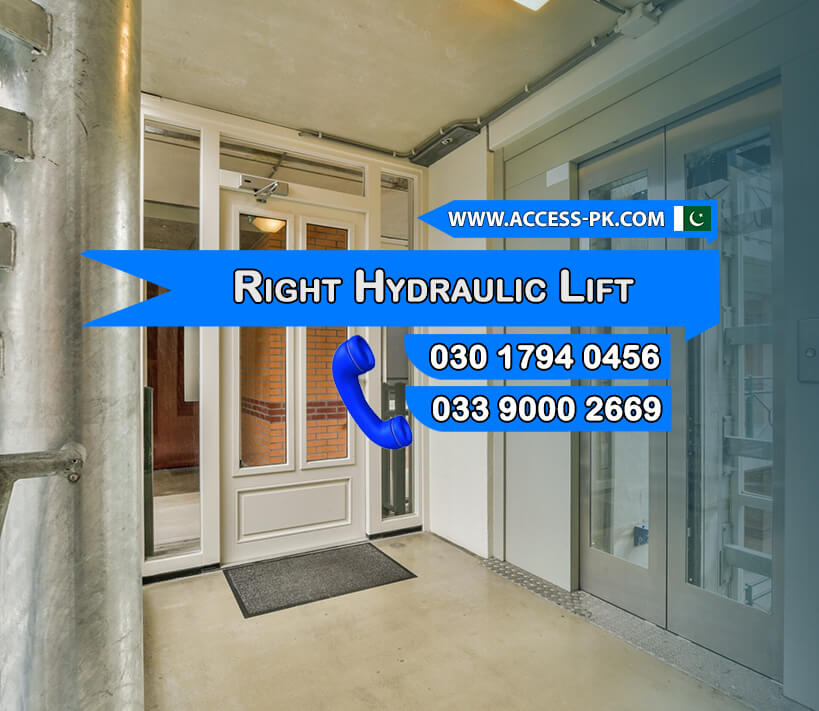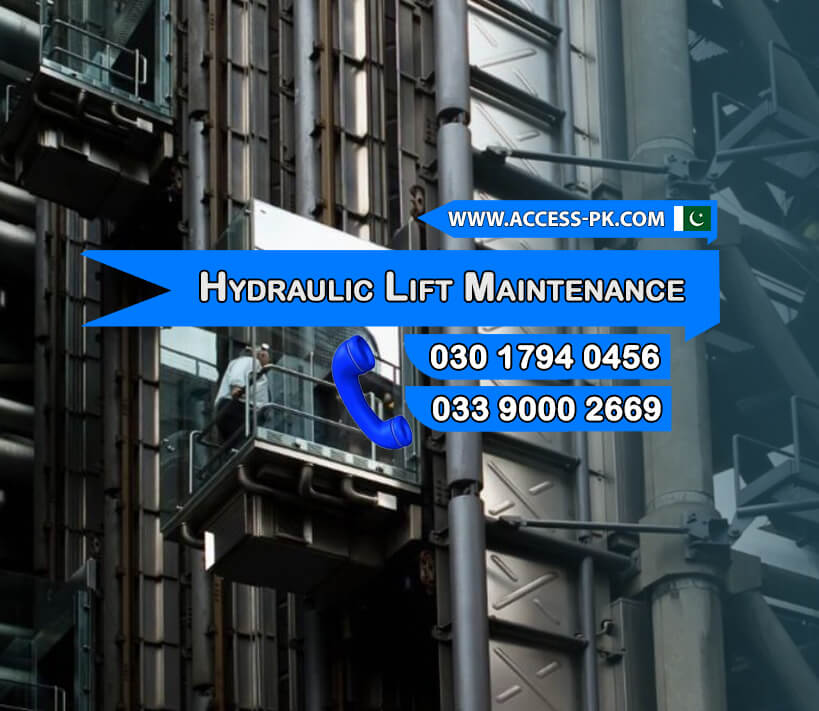Are you looking for a durable and efficient hydraulic lift? Do you need to streamline the transport of heavy goods while ensuring smooth and reliable operation? You’ve come to the right place. Our company specializes in high-performance hydraulic lifts, designed for strength, safety, and exceptional efficiency.
Hydraulic lifts are a modern and efficient solution for vertical transportation, offering smooth and reliable movement. At Access Technologies, owned by Imran Rafi, we specialize in providing high-quality hydraulic lifts for various applications, from residential buildings to industrial facilities. The primary advantage of a hydraulic lift is its ability to handle heavy loads with ease, ensuring safety and efficiency. Additionally, hydraulic lifts are relatively easy to maintain, making them an ideal choice for buildings requiring minimal downtime and long-term reliability. These systems are also cost-effective, especially in low-rise buildings, due to their simple design.
One of the key reasons why hydraulic lifts are favored is their energy efficiency. Unlike other lift systems, hydraulic lifts operate using a fluid-driven piston, making them energy-efficient and environmentally friendly. Moreover, hydraulic lifts are known for their quiet operation, which adds to the comfort of the building’s occupants. As a result, these lifts are a popular choice for spaces where noise reduction is a priority, such as in residential buildings and offices. Furthermore, they require less space compared to other lift systems, providing greater flexibility in installation.
Hydraulic lift systems are incredibly versatile and adaptable to various building types. They are particularly useful in low to mid-rise buildings, where their smooth operation can greatly enhance accessibility. These lifts can be customized to fit specific requirements, offering a tailored solution for each project. Additionally, the ease of installation and low maintenance costs make hydraulic lifts an attractive option for developers. They provide reliable and consistent performance, ensuring that the lift operates efficiently for many years, thus offering significant value for money over time.
Get Free Quotes
Hydraulic lifts operate on a simple yet effective principle. They use a hydraulic fluid to transmit force from one point to another, which allows the lift to move vertically with smoothness and precision. A piston moves within a cylinder to make this possible. When the hydraulic fluid pumps into the cylinder, it pushes the piston up, lifting the platform. The key benefit of this mechanism is its ability to carry heavy loads effortlessly while maintaining a compact and efficient design. Hydraulic lifts are widely used in various industries and applications, providing a reliable and cost-effective solution for vertical transportation. These systems are particularly useful in settings where other lifts might not be practical, due to space or budget constraints. Furthermore, hydraulic lifts offer exceptional safety features and ease of maintenance, making them a popular choice in both residential and commercial settings.
The basic operation of a hydraulic lift is based on Pascal’s Law, which states that when pressure is applied to a fluid in a confined space, it is transmitted equally in all directions. In a hydraulic lift, a pump pushes fluid into a cylinder, which in turn raises the lift platform. As the fluid moves, it creates pressure that causes the piston to lift the load. The force exerted by the piston is directly proportional to the surface area of the piston, allowing for a higher lifting capacity without needing a larger motor. Additionally, hydraulic lifts operate with very few moving parts, making them easy to maintain and reducing the risk of mechanical failure.
Hydraulic lifts are extremely versatile and serve a wide range of settings. You commonly find them in buildings where vertical transportation is necessary but space or power limitations exist. Residential buildings often use hydraulic lifts to assist people with mobility challenges, making them an essential tool in providing accessibility. Additionally, hydraulic lifts are frequently used in warehouses, manufacturing plants, and freight elevators for moving goods between floors. Their ability to carry heavy loads makes them an indispensable tool in industries that require the safe transportation of materials. They are also widely used in car service centers, enabling easy access to vehicles for repairs or maintenance.
Hydraulic lift systems offer several key advantages that make them a popular choice for many applications. One of the main benefits is their ability to carry heavy loads efficiently. Unlike other lift systems, hydraulic lifts can handle substantial weight with ease, making them ideal for industrial settings and warehouses. Additionally, hydraulic lifts are known for their quiet and smooth operation, contributing to a more comfortable environment in residential and office buildings. Another significant advantage is the system’s durability. Hydraulic lifts are less prone to wear and tear, making them a long-lasting investment. They also require minimal maintenance, which further reduces long-term operational costs. The efficiency of hydraulic lift systems, combined with their low energy consumption, makes them an eco-friendly choice that can help reduce energy costs for building owners.
Get Free Quotes
Hydraulic lifts offer numerous benefits in both residential and business settings. In homes, these lifts significantly enhance accessibility, making it easier for people with mobility challenges to move between floors. Whether for elderly individuals or those with disabilities, a hydraulic lift can provide the convenience of vertical transportation without the need for stairs. The smooth and quiet operation of hydraulic lifts ensures that they blend seamlessly into a home environment without disrupting daily life. Furthermore, they require less space than traditional elevator systems, making them ideal for homes with limited room. For businesses, hydraulic lifts are an excellent solution for transporting heavy goods or equipment between floors. Their ability to lift substantial weight without compromising on efficiency makes them indispensable in industries such as retail, manufacturing, and warehouses. With low maintenance costs and a long lifespan, businesses can rely on hydraulic lifts for consistent performance, reducing downtime and increasing productivity.
In addition to enhancing accessibility, hydraulic lifts can increase the overall value of a property. Homes and businesses that are equipped with hydraulic lifts are often seen as more modern and functional, which can attract potential buyers or clients. They provide an added level of convenience and safety, particularly in multi-story buildings. For businesses, hydraulic lifts also contribute to operational efficiency by reducing the need for manual labor in moving heavy items. Whether it’s in a commercial or residential setting, the low operating cost of hydraulic lifts ensures long-term savings, making them a smart and valuable investment.
Get Free Quotes
Choosing the right hydraulic lift is crucial to ensuring optimal performance and meeting the specific needs of a building. One of the first factors to consider is the weight capacity of the lift. Hydraulic lifts come in various sizes, each designed to handle different weight loads. For residential use, a smaller lift may be sufficient for transporting people and light items, while businesses that need to move heavy goods or equipment may require a higher capacity lift. It’s important to assess the building’s requirements and select a lift that offers the necessary load-bearing capacity while also considering future needs. Another key factor is the available space for installation. Hydraulic lifts generally require less space than traditional lifts, but careful measurement is essential to ensure a proper fit, especially in smaller or older buildings.
Additionally, it’s important to choose a hydraulic lift that aligns with safety standards and offers features tailored to the building’s environment. For example, residential lifts may include additional safety features such as emergency stop buttons and smooth landing systems, while business lifts may require custom designs to accommodate industrial-grade equipment. The reliability and maintenance requirements of the hydraulic lift are also critical considerations. Opting for a lift that has a proven track record of durability and low maintenance can help save money in the long term. Lastly, choosing a hydraulic lift that complements the building’s aesthetic and functional requirements ensures that it not only performs well but also integrates seamlessly into the structure’s design.
Get Free Quotes
Maintaining a hydraulic lift is essential to ensure its longevity, safety, and optimal performance. Regular inspections and testing of the hydraulic lift are critical in identifying potential issues before they become serious problems. Operators should carefully inspect the lift’s components, including the hydraulic cylinder, piston, and control valves, to ensure there are no signs of wear or damage. A thorough inspection should also involve checking the hydraulic fluid levels and ensuring that the lift’s safety systems, such as emergency stops and door sensors, are functioning properly. Additionally, regular testing of the lift helps verify that it operates smoothly and meets safety standards. Ensuring that the hydraulic lift is operating correctly not only improves efficiency but also reduces the likelihood of unexpected breakdowns, saving time and costs for both residential and business users.
Regular inspection and testing are fundamental aspects of hydraulic lift maintenance. Routine checks of the hydraulic system, including the piston, pump, and control valves, help identify wear and tear early. This proactive approach reduces the risk of mechanical failures, ensuring that the lift operates efficiently and safely. You should test the lift’s performance periodically to verify that it moves smoothly and stays within its designated weight capacity. Operators should also assess the emergency stop functions and safety features to ensure they are fully operational. By conducting regular inspections and tests, building owners can minimize downtime and ensure that the hydraulic lift continues to perform at its best while meeting safety standards. Regular inspections also help identify any hydraulic fluid leaks or irregularities that could compromise the system’s functionality.
Lubrication and fluid checks are crucial in maintaining the optimal performance of a hydraulic lift. The hydraulic fluid serves as the lifeblood of the system, enabling smooth operation by facilitating the transfer of force. Over time, the fluid can become contaminated or degrade, which can negatively impact the lift’s performance. It’s essential to regularly check the fluid levels and ensure they are topped up as needed. Additionally, operators should inspect the quality of the fluid and replace it when it shows signs of contamination or degradation. Lubricating moving parts, such as the piston rods and lift guide rails, is equally important. Proper lubrication reduces friction, prevents wear, and extends the lifespan of the hydraulic lift. Ensuring proper lubrication of the lift and maintaining the fluid in good condition prevents mechanical failures and keeps the lift running smoothly.
Safety protocols for operators are an essential part of hydraulic lift maintenance and operation. Operators must receive proper training on the lift’s specific functions and safety features. They should know the lift’s weight capacity and ensure they do not overload it, as this can cause system malfunctions or accidents. The operating environment around the hydraulic lift should also be free of obstructions to prevent accidents. Additionally, operators must ensure that the safety features, such as emergency stop buttons and door sensors, are functioning correctly before using the lift. Regular training on emergency procedures and safety protocols is also vital to ensure that operators can handle unexpected situations effectively. By following these safety guidelines, operators can minimize the risk of accidents and use the hydraulic lift safely and efficiently.
Get Free Quotes12-D, DHA EME Sector, Lahore, Pakistan
Ameer Chowk, Street Number 16, Township Block 5 Twp Sector C 2 sector C-II, Lahore, Pakistan
Royal Plaza, Main Ghouri Garden, Islamabad, Pakistan